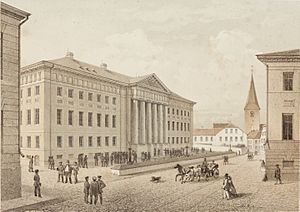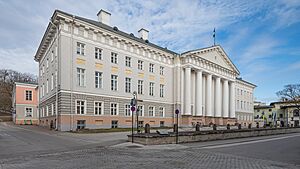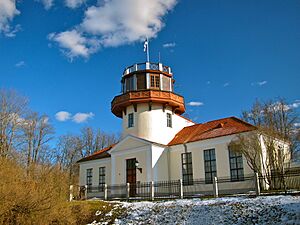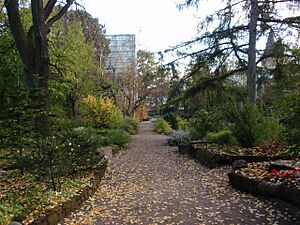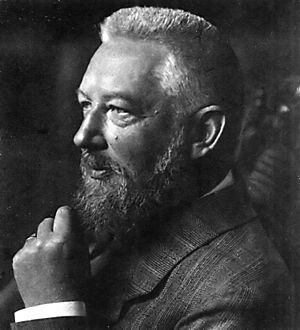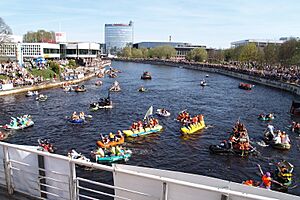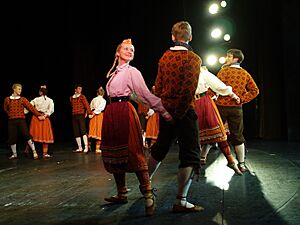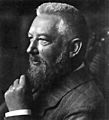University of Tartu facts for kids
|
Tartu Ülikool
|
|
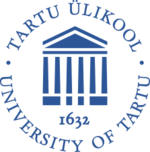 |
|
| Latin: Universitas Tartuensis | |
|
Former names
|
Academia Gustaviana, University of Dorpat/Yuryev, Tartu State University |
|---|---|
| Type | Public |
| Established | 1632 (closed 1710–1802) |
| Founder | Gustavus Adolphus |
| Budget | €264 million (2024) |
| Rector | Toomas Asser |
|
Academic staff
|
2,001 |
|
Administrative staff
|
1,538 |
| Students | 14,778 |
| Undergraduates | 9,327 |
| Postgraduates | 4,317 |
| 1,134 | |
| Location |
,
58°22′52″N 26°43′13″E / 58.38111°N 26.72028°E |
| Campus | Urban (University town) |
| Colours | White Blue |
| Nickname | UT, unitartu |
| Affiliations | CBUR, EUA, Coimbra Group, Utrecht Network, Atomium Culture Guild of European Research-Intensive Universities |
| Mascot | Tiksu |
The University of Tartu (often called UT) is a public research university in Tartu, Estonia. It is the main national university of Estonia and also the oldest and largest in the country. The university was started in 1632 by Baron Johan Skytte and approved by King Gustavus Adolphus of Sweden. It was first known as Academia Gustaviana.
Today, over 15,000 students attend the university, with more than 1,500 coming from other countries. Most classes are taught in Estonian. However, there are also 30 programs taught in English. These include three programs for undergraduate students and 27 for master's students.
The university's old buildings are special because they show the ideas of universities during the Age of Enlightenment. The University of Tartu is part of important groups like the Coimbra Group and the Utrecht Network.
The university's mascot is a blue bird named Tiksu.
Contents
History of the University
Academia Gustaviana: The Beginning
The University of Tartu began as the Academia Gustaviana in 1632. It was located in the Swedish area called Livonia. This was the second university created in the Swedish Empire. Before this, there was a Jesuit school in Tartu from 1583 to 1601.
The first students joined the university in April 1632. The official opening happened on October 15, 1632. The university had different departments, like philosophy, law, and medicine. It was similar to the University of Uppsala in Sweden.
Because of a war between Russia and Sweden, the university moved to Tallinn in 1656. It then closed down in 1665. Important scholars from Sweden studied here in the 1600s.
Academia Gustavo-Carolina: A New Start
The university reopened in 1690 as the Academia Gustavo-Carolina. This made Tartu a university town again. Famous teachers at this time included Sven Dimberg, who was the first in the world to teach based on Isaac Newton's ideas.
Less than ten years later, due to another war and a big famine, the university moved from Tartu to Pärnu. It opened in Pärnu in August 1699. However, it closed again in 1710 when Russian forces took over Pärnu during the Great Northern War. The university did not reopen until 1802.
Universität Dorpat: German Influence
The university was reopened in April 1802 by the Baltic Germans in Estonia. From 1802 to 1893, classes were taught in German. During this time, the university was both German-speaking and connected to Russian universities. Many professors came from Germany.
The period between 1860 and 1880 was considered its "golden age" for research. The university helped train leaders and professionals for the Russian Empire.
Later, Russia wanted to make everything more uniform. Between 1882 and 1898, the Russian language became more important. Many scholars from Germany left. By 1898, the town and university were renamed Yuryev. The University of Yuryev continued until 1918. Russian staff and students moved to Voronezh, Russia, and started Voronezh State University.
University of Tartu: Modern Times
After Estonia became independent in 1918, the University of Tartu became an Estonian-language university in 1919. During the Soviet occupation, it was called Tartu State University. While Estonian was the main language, some classes were taught in Russian.
Estonia became independent again in 1991. The university fully regained its freedom in 1992. Now, no courses are taught in Russian. The university has changed a lot to fit modern university models. It has also adopted the Bologna declaration, which changed how studies and degrees work.
University Buildings and Facilities
The University of Tartu has many buildings, museums, and sports facilities. Most of these are open to everyone. The university owns 56 buildings, with 11 of them outside of Tartu. Thirty-one of its buildings in Tartu are important architectural landmarks.
In May 2023, the university launched a virtual tour. You can see 360-degree photos of over 160 places on the campus.
Many new university buildings and student dorms have been built or updated recently. Some new buildings are in an area called Maarjamõisa, about 2 kilometers from the main university center. These include the Technology Institute and the Chemistry building.
Research and Discoveries
The University of Tartu is a leader in science in Estonia. It is known for its research in many areas. For example, the study of lectins began here in 1888.
The university has made important discoveries in molecular and cell biology, laser medicine, and psychology.
UT is among the top 1% of the world's most-cited universities in many fields. This means their research is often used and referred to by other scientists. Some of these fields include:
- Biology and biochemistry
- Chemistry
- Clinical medicine
- Engineering
- Environmental studies
- Materials science
- Computer science
More than half of all PhD degrees in Estonia are earned at UT. Also, over 2,000 high-level research articles are published by UT scientists each year. About 50 UT scientists are among the top 1% of the most-cited scientists globally.
Working with Businesses
The University of Tartu works with many businesses. It has contracts worth millions of euros with over 150 companies. UT is one of the biggest partners for private and public groups in the Baltic region. It works with large international companies like Swedbank and Pfizer.
The university has helped start more than 60 new companies. One big success story is the technology for a special bacterium used in the food industry.
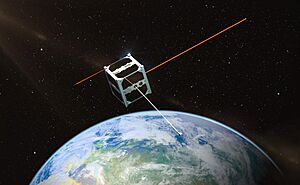
A cool project was the ESTCube-1 satellite. It was built by UT staff and students and launched into space in 2013. This made Estonia the 41st country to have a satellite in orbit!
Scientists from UT have also developed new materials for 3D-printed houses. They also helped create the Rakuten Fits Me technology, which is like a virtual dressing room.
The university encourages its students to think like entrepreneurs. It wants them to use their knowledge to create new businesses and ideas.
How the University is Organized
The University of Tartu has different parts, including institutes and colleges. These are grouped into four main faculties:
- Faculty of Arts and Humanities
- Faculty of Social Sciences
- Faculty of Medicine
- Faculty of Science and Technology
The university also has other support units. While most of the university is in Tartu, it also has locations in Narva, Pärnu, Tallinn, and Viljandi. For example, the Narva and Pärnu Colleges are part of the Faculty of Social Sciences.
What You Can Study
Nearly a quarter of all university students in Estonia study at the University of Tartu. Most courses are in Estonian, but many degree programs are taught in English.
About 35% of UT's courses are offered online. These include web-based courses, video lectures, and online workshops.
The university offers 61 different bachelor's programs and 86 master's programs. Thirty of these programs are taught entirely in English.
Bachelor's Programs in English
Three bachelor's degree programs are fully taught in English:
- Business Administration
- Medicine
- Science and Technology
Master's Programs in English
The University of Tartu has 27 international master's programs in English. Some examples include:
- Faculty of Arts and Humanities: European Languages and Cultures, Semiotics.
- Faculty of Social Sciences: Digital Administration, International Relations and Regional Studies.
- Faculty of Science and Technology: Computer Science, Robotics and Computer Engineering.
- Faculty of Medicine: Clinical Nutrition, Clinical Pharmacy.
Doctoral Studies
About 120 doctoral degrees are completed each year at UT. This is more than half of all doctoral degrees in Estonia. The university has over 1,100 doctoral students, with about 30% from other countries. Doctoral programs are offered in all four faculties. Since 2022, many doctoral student positions are funded by the state.
Continuing Education
The University of Tartu is the largest provider of continuing education in Estonia. It offers about 1,200 courses each year to over 39,000 people. These courses help people learn new skills or improve existing ones.
University Rankings
| University rankings | |
|---|---|
| Global – Overall | |
| ARWU World | 701–800 (2023) |
| QS World | =362 (2026) |
| THE World | 301–350 (2024) |
| USNWR Global | =256 (2023) |
The University of Tartu is highly ranked among universities worldwide. In 2024, the QS World University Rankings placed it 358th globally. It is the top-ranked university in the Baltic countries. The Times Higher Education World University Rankings put it in the top 251–300 universities in the world.
UT is the only university in the Baltic countries to be in the top 200 universities in Europe. It is also in the top 1% of the world's most-cited universities in 15 different research areas.
Famous Alumni
Many important people have studied at the University of Tartu. As of 2016, all Estonian judges, almost all Estonian doctors and pharmacists, and most Estonian lawyers studied here. Also, many members of the Estonian government and parliament are alumni of UT.
Working with Other Countries
The University of Tartu has about 1,800 international students from 90 different countries. Most of these students come from Ukraine, Russia, and Finland.
The university works with over 800 other universities through the Erasmus programme for student exchange. This allows students to study abroad.
Foreign students have given the university good reviews. It has even won an International Student Satisfaction Award.
The University of Tartu is part of several international university groups. It also has agreements with about 70 universities around the world to work together.
Statue of Gustav II Adolf
A statue of King Gustav II Adolf of Sweden, who formally founded the university, was put up in 1928. It was removed in 1950 during the Soviet occupation. A new statue was put in its place in 1992. It was opened by King Carl XVI Gustaf and Queen Silvia of Sweden. The new statue was made by Elisabeth Tebelius-Myren.
Images for kids
-
The first Estonian satellite ESTCube-1 was developed mainly by the students from the University of Tartu.
-
The Baltic German chemist Wilhelm Ostwald received the Nobel Prize in Chemistry in 1909.
See also
 In Spanish: Universidad de Tartu para niños
In Spanish: Universidad de Tartu para niños


